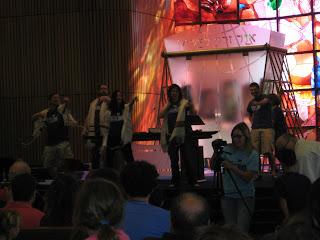We are commanded in the Torah to be joyous on this holiday. Obviously, there are many ways to rejoice, and our Temple Isaiah Religious School found a unique way to do so this year - we held a flash mob during our t'fila (prayer) service between the two sessions. The clergy, Religious School staff, TA's, students and their families practiced dance moves for several weeks; all the rehearsing paid off, and the flash mob truly turned out to be an incredibly joyous and fun experience for all.
During our Edot sessions before and after t'fila, the students were introduced to the major symbols of Sukkot - the Sukkah and the Lulav/Etrog. As we practiced the ritual of shaking the lulav, a few students remarked how similar the sound of the shaking palm, myrtle, and willow branches was to the sound of a gentle rain falling. This is not a coincidence, as it is this time of year, as part of our Sukkot celebration, that we ask God to bring rain for the crops.
Edot students also continued to build a working Hebrew vocabulary through the "Hebrew Through Movement" program - reviewing the commands "la'koom" (get up), "la'shevet" (sit down), and "la'lechet (walk), and learning a new command - "la'atzor" (stop). They also began to read "Hebrish" (English words written with Hebrew letters). Working in pairs or in groups of 3, they read out loud to each other, correcting any decoding errors when a word didn't make sense to them. This is the beauty of working with Hebrish - the students know immediately if they are decoding correctly or not. Each student has a binder, within which are readings, puzzles and games, all written in Hebrish. Students were asked to read a "welcome to our Edot class" letter from me, to help them become familiar with Hebrish. Once they finish reading the letter, they can choose to read any worksheet in the binder. For example, they might choose the riddle, "Why did the boy throw a clock out of the window?" (Answer: to see time fly!), or they might choose to read one of several limerick poems, or fill-in-the blank worksheets, where, as an example, they might be asked to read a description of a famous fairy tale, and write the title on the blank line. (Just as they must read in Hebrish, they must write their answers in it as well!) The students may also take worksheets home from the binder, and bring them back for stickers in our "Stumper/Challenge" incentive program.Eventually, the students will be reading about chapters in Jewish history, the origins of major Jewish holidays and prayers, and even excerpts from the first part of the Mishna - Pirkei Avot (The Sayings of the Fathers) - all in Hebrish (with some Hebrew vocabulary introduced every now and then).
Judging from the faces of the students during the Hebrew Through Movement and Hebrish decoding activities, they enjoyed both, which was quite appropriate as Sukkot, our "Z'man Simchateinu," our time of joy, was just about to begin. Having Joel Siegel, our music director, come in at the end of each session to teach us some wonderful songs relating to Sukkot, was icing on the cake!
Chag Sukkot Sameach.









No comments:
Post a Comment